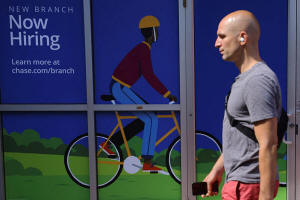Sharp slowdown in US job growth boosts unemployment rate to 4.3%
 Send a link to a friend
Send a link to a friend
 [August 03, 2024] By
Lucia Mutikani [August 03, 2024] By
Lucia Mutikani
WASHINGTON (Reuters) - The U.S. unemployment rate jumped to near a
three-year high of 4.3% in July amid a significant slowdown in hiring,
heightening fears the labor market was deteriorating and potentially
making the economy vulnerable to a recession.
The increase in the unemployment rate from 4.1% in June marked the
fourth straight monthly increase, the Labor Department reported on
Friday.
Its rise from a five-decade low of 3.4% in April 2023 to now the highest
level since September 2021 all but guarantees a September interest rate
cut from the Federal Reserve, with economists calling for a 50 basis
point reduction in borrowing costs. They argue that the U.S. central
bank is most likely behind the curve in easing monetary policy.
The sharp slowdown in the labor market had been flagged for a while in
sentiment surveys and a rise in the number of people on unemployment
benefits. The Fed's rate hikes in 2022 and 2023 have weighed on demand
for labor, with government data this week showing hires in June were the
lowest in four years.
The employment report, which also showed the increase in annual wages
last month was the smallest in more than three years, prompted some Wall
Street institutions, including Bank of America Securities, to pull
forward their rate cut expectations to September from December. Goldman
Sachs now anticipates three rate cuts this year instead of only two
before the data.
"If Fed officials had seen this report, they would have cut rates by 25
basis points this week," said Brian Bethune, an economics professor at
Boston College. "There is absolutely no justification for continuing to
exert an elevated level of monetary restrictiveness on the economy."

Nonfarm payrolls increased by 114,000 jobs last month, the Labor
Department's Bureau of Labor Statistics said. That was well below the
215,000 jobs per month added over the last 12 months, and the at least
200,000 that economists say are needed to keep up with growth in the
population, accounting for the recent surge in immigration.
Economists polled by Reuters had forecast payrolls would advance by
175,000 jobs. The establishment survey, from which payrolls are counted,
also showed the economy created 29,000 fewer jobs in May and June than
previously reported.
The BLS said Hurricane Beryl, which slammed Texas during the survey week
of the July employment report, had "no discernible effect" on the data.
The household survey, however, showed 436,000 people reported that they
could not report to work because of bad weather last month, the highest
on record for July. There were 249,000 people on temporary layoff last
month.
The average workweek fell to 34.2 hours from 34.3 hours in June, also
suggesting that Beryl had some impact on the labor market. But
construction payrolls increased as did leisure and hospitality
employment, which would weaken the weather argument.
The healthcare sector continued to lead employment gains, with payrolls
rising by 55,000 jobs. Construction payrolls increased by 25,000 jobs,
while leisure and hospitality added 23,000 positions.
Government employment rose by 17,000 jobs. There were also employment
gains in the transportation and warehousing as well as social assistance
sectors.
But information industry payrolls dropped 20,000 jobs. Financial
activities lost jobs as did professional and business services, with
temporary help services positions - a harbinger of future hiring -
declining by a further 8,700.
[to top of second column] |

A pedestrian passes a "Now Hiring" sign at a Chase Bank branch in
Somerville, Massachusetts, U.S., September 1, 2022. REUTERS/Brian
Snyder/File Photo

The breadth of job gains continued to narrow, with 49.6% of
industries reporting an increase in employment, down from 56.0% in
June.
Fed Chair Jerome Powell told reporters on Wednesday that while he
viewed the changes in the labor market as "broadly consistent with a
normalization process," policymakers were "closely monitoring to see
whether it starts to show signs that it's more than that."
Stocks on Wall Street fell sharply. The dollar dropped to a
four-month low against a basket of currencies. U.S. Treasury prices
rose, with the yield on the benchmark 10-year note falling to its
lowest since December.
WAGE GROWTH COOLS
The Fed on Wednesday kept its benchmark overnight interest rate in
the 5.25%-5.50% range, where it has been for more than a year but
opened the door to reducing borrowing costs as soon as its next
meeting in September. Financial markets and economists are also
expecting rate cuts in November and December.
Average hourly earnings rose 0.2% last month after climbing 0.3% in
June, likely impacted by a calendar quirk as the survey week in July
did not include the 15th.
In the 12 months through July, wages increased 3.6%, the smallest
year-on-year gain since May 2021 and following a 3.8% advance in
June. That left wage growth just above the 3%-3.5% range seen as
consistent with the Fed's 2% inflation target, extending the run of
inflation-friendly data.
While the jump in the unemployment rate triggered the Sahm rule on
recessions, economists pushed back against concerns that a downturn
could already be underway. They argued that the rise in the jobless
rate was not because of layoffs, but rather an immigration induced
jump in labor supply.
About 420,000 people entered the labor force last month, while
household employment only increased by 67,000 jobs. The number of
people working part-time for economic reasons increased by 346,000
to 4.6 million. But there were little changes in permanent job
losers and long-term unemployment.
A broader measure of unemployment, which includes people who want to
work but have given up searching and those working part-time because
they cannot find full-time employment, surged to 7.8% after holding
at 7.4% for three straight months.
"This doesn't look like the start of a recession, where demand drops
away from supply," said Tara Sinclair, director of the GW Center for
Economic Research. "But it's still weakness. The Fed has medicine to
treat this weakness."
(Reporting by Lucia Mutikani; Editing by Andrea Ricci, Chizu
Nomiyama and Paul Simao, Kirsten Donovan)
[© 2024 Thomson Reuters. All rights
reserved.]
This material may not be published,
broadcast, rewritten or redistributed.
Thompson Reuters is solely responsible for this content.
 |